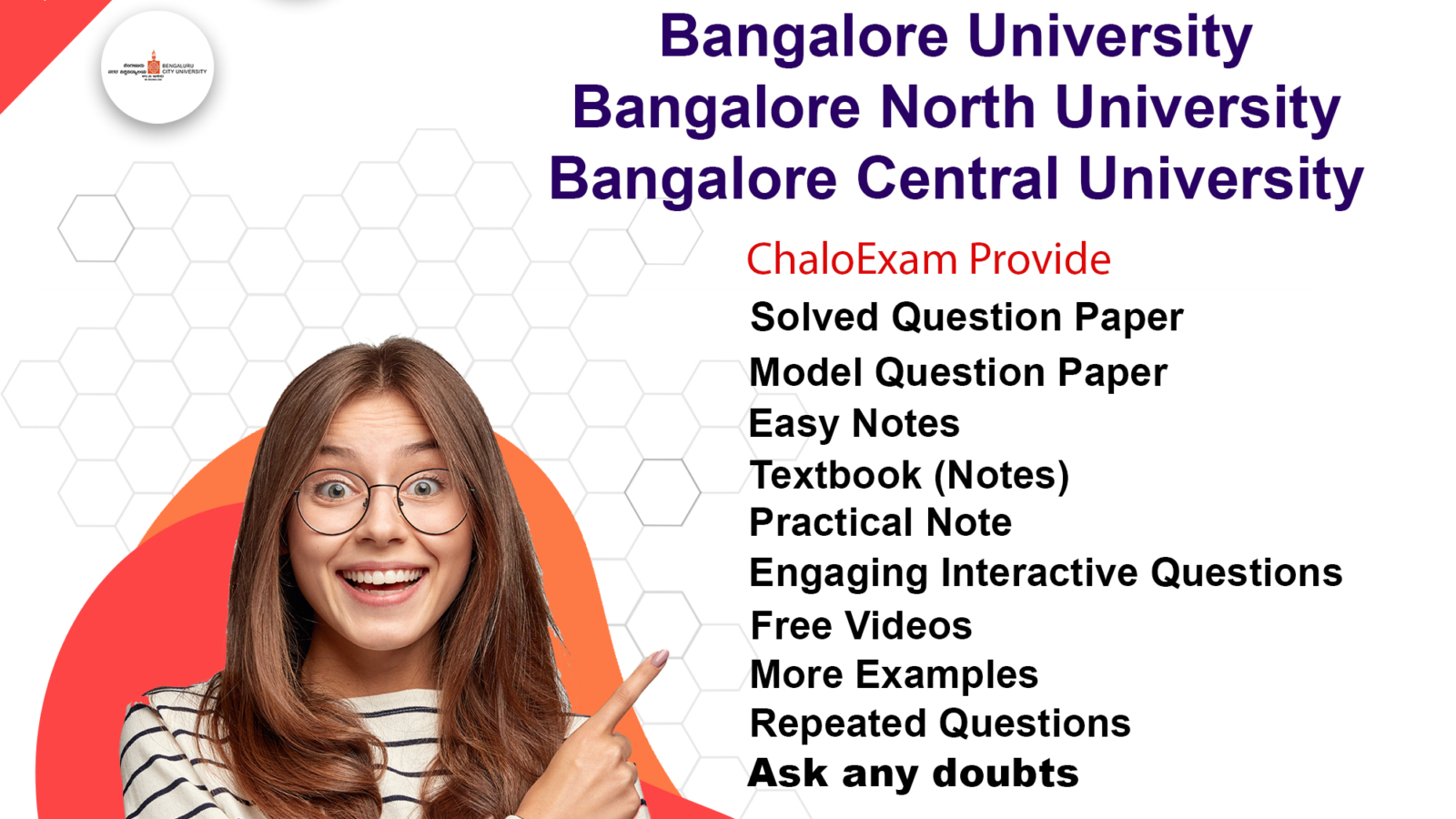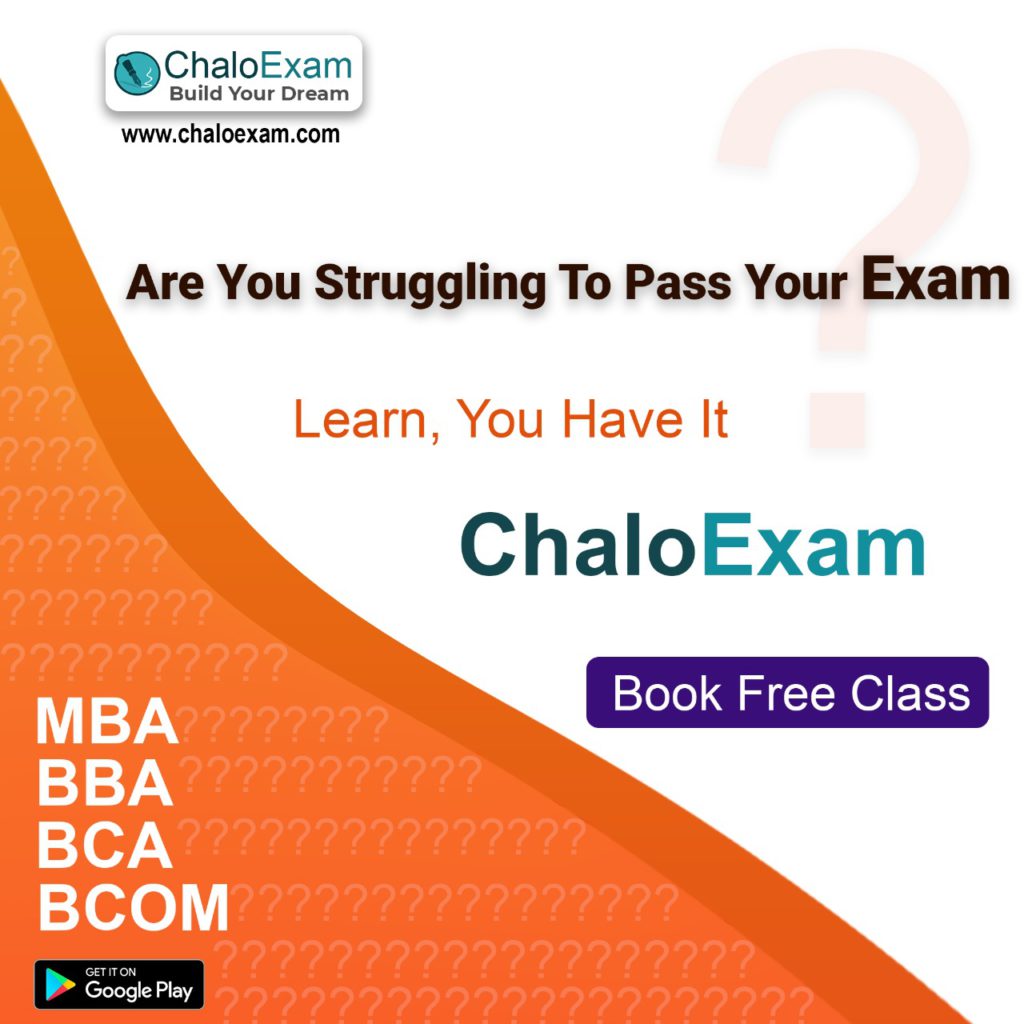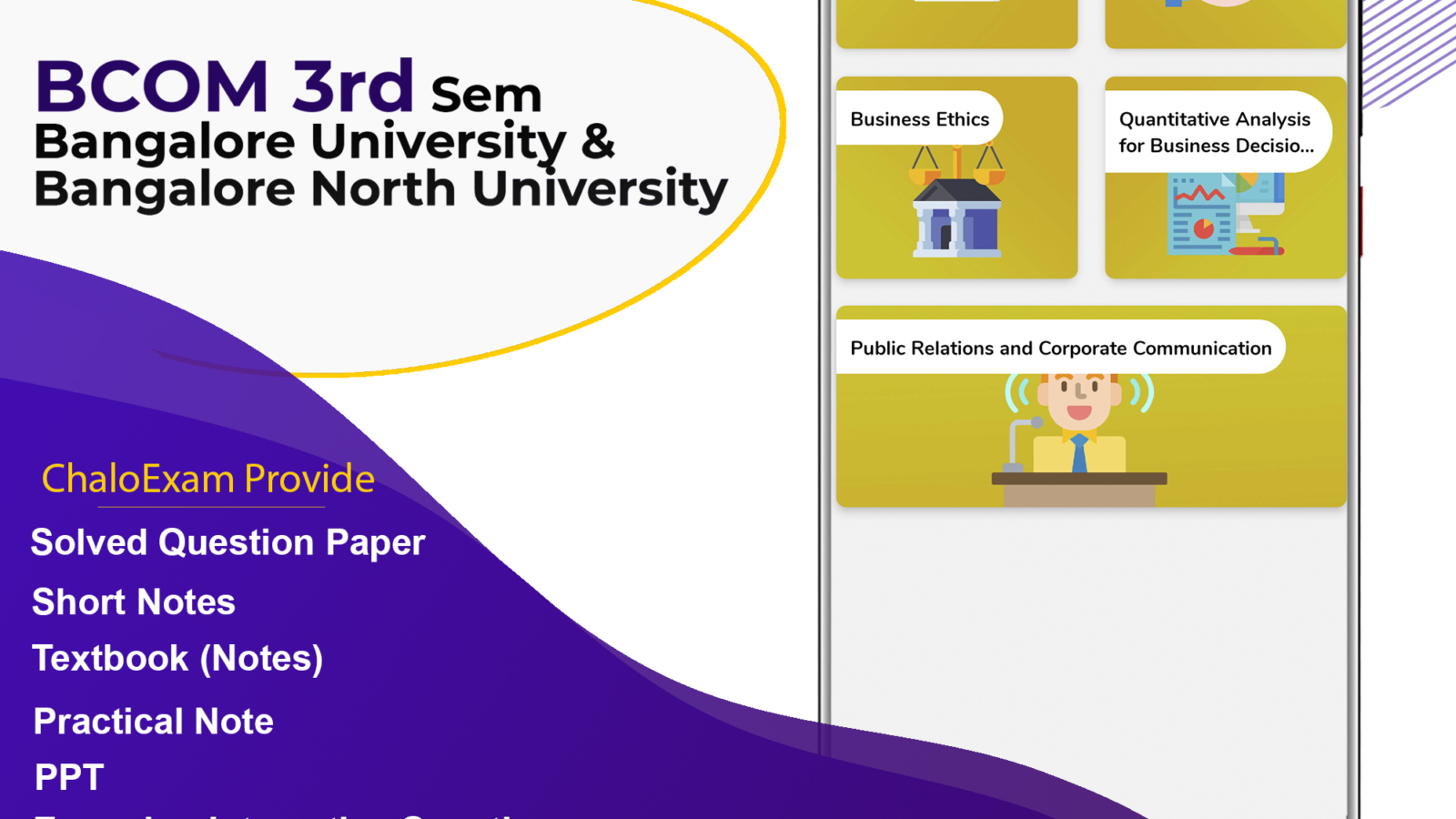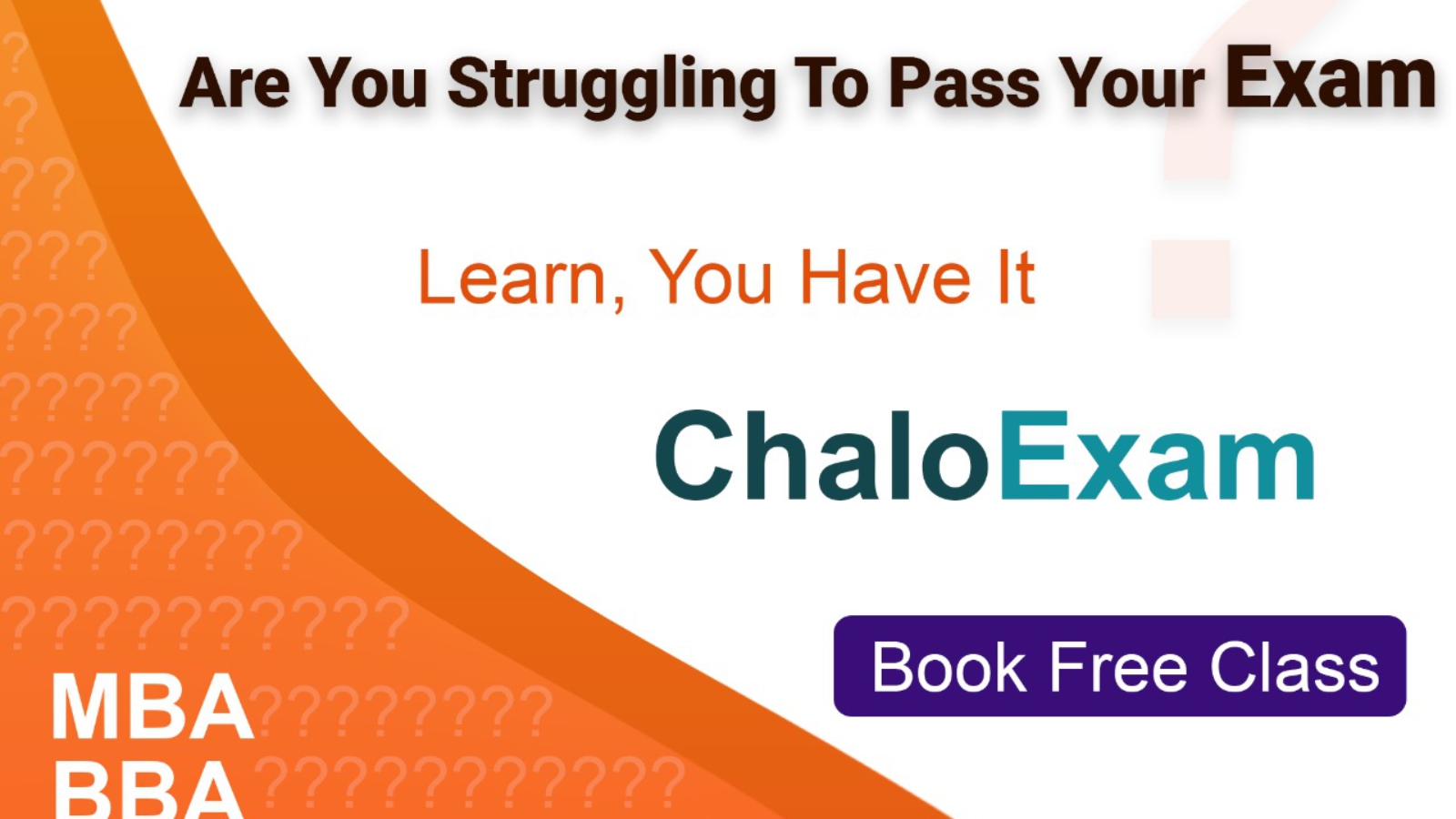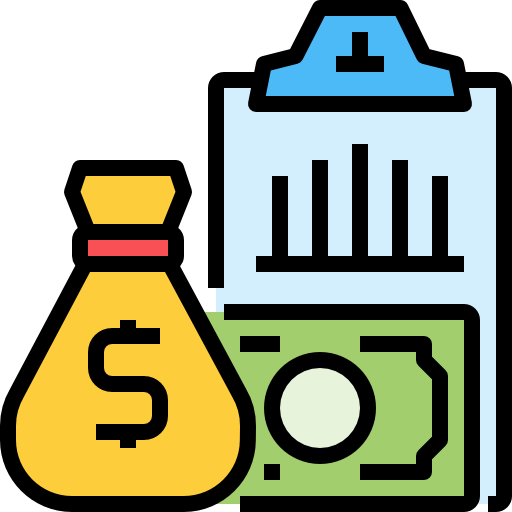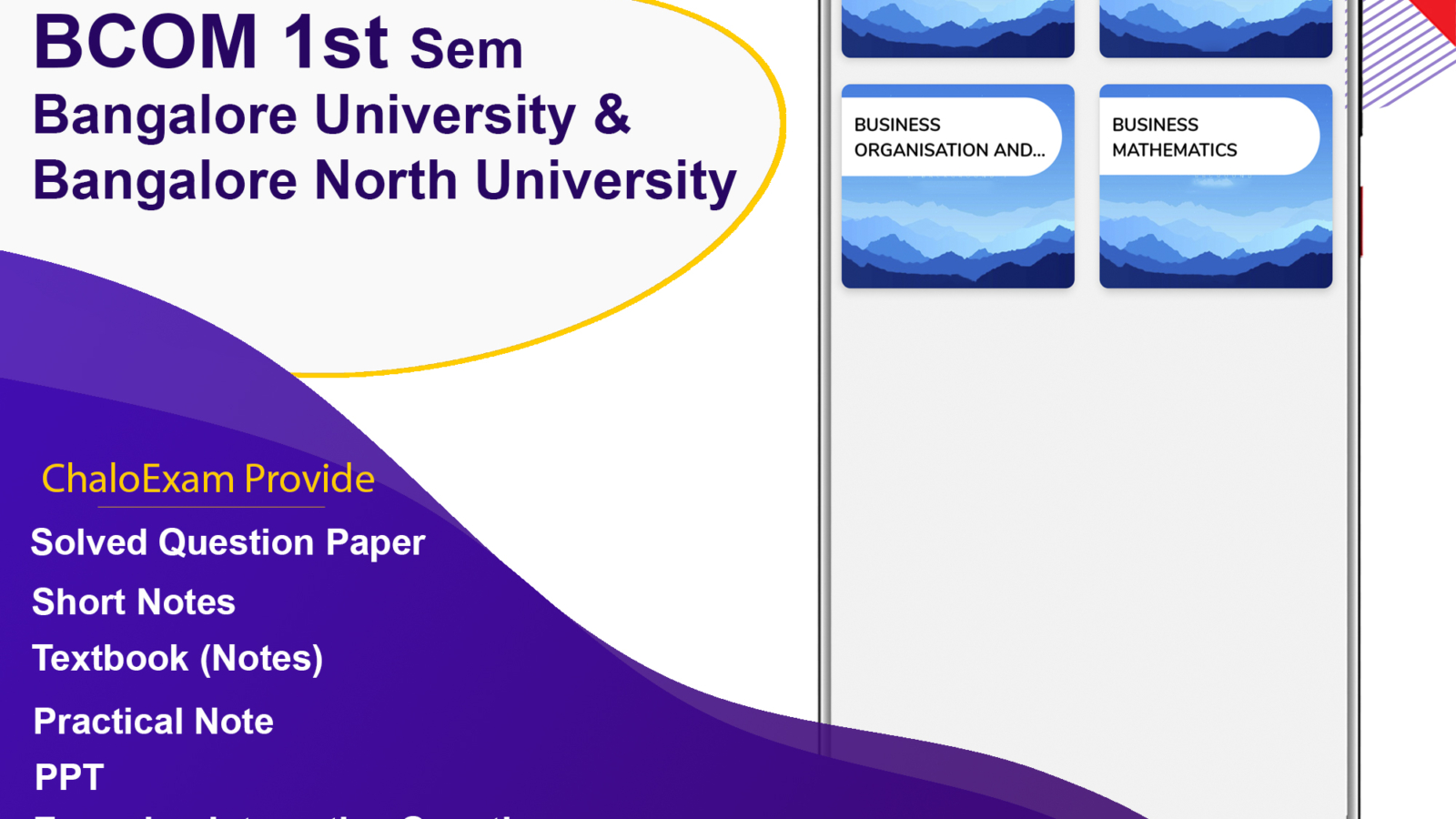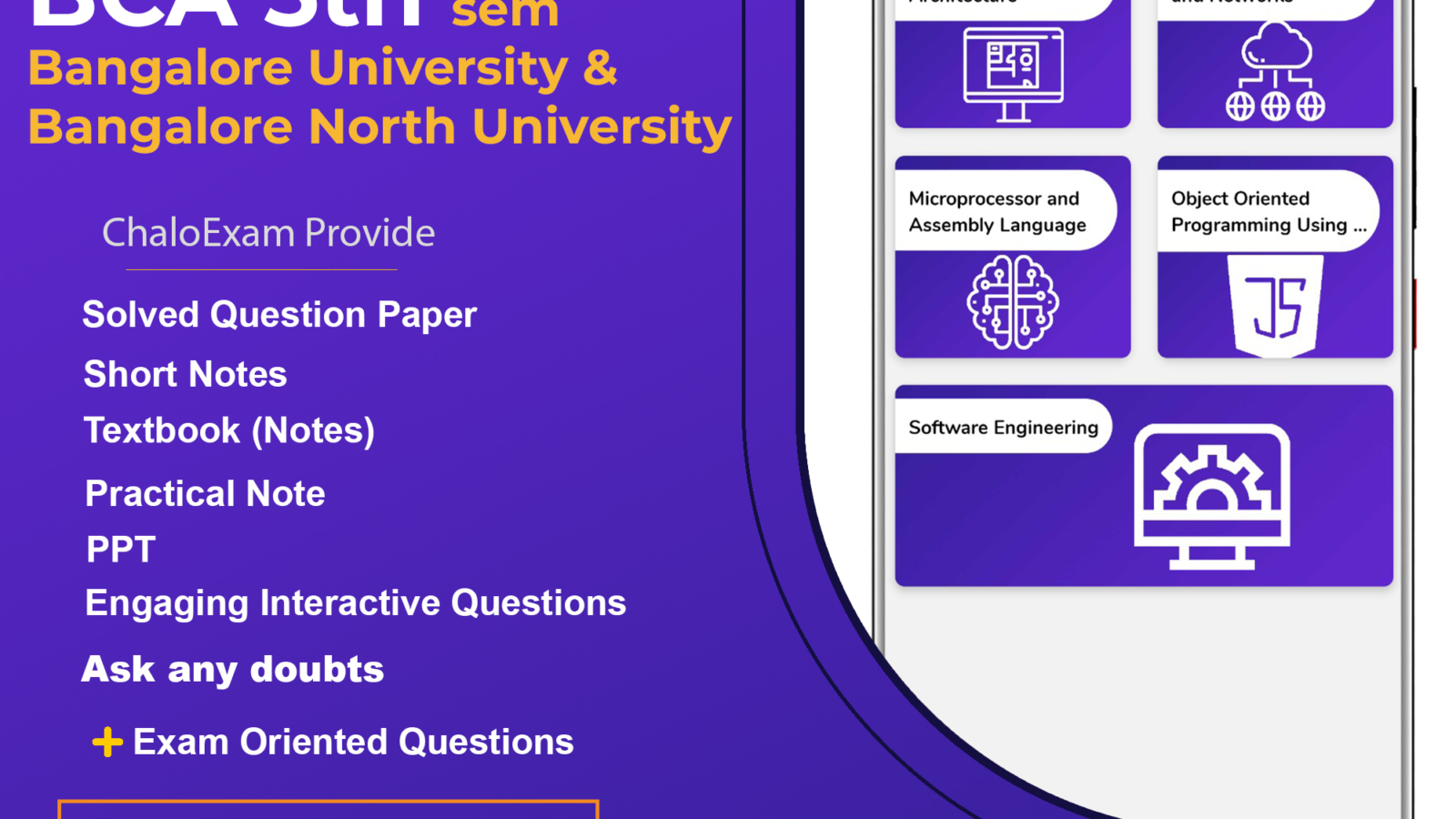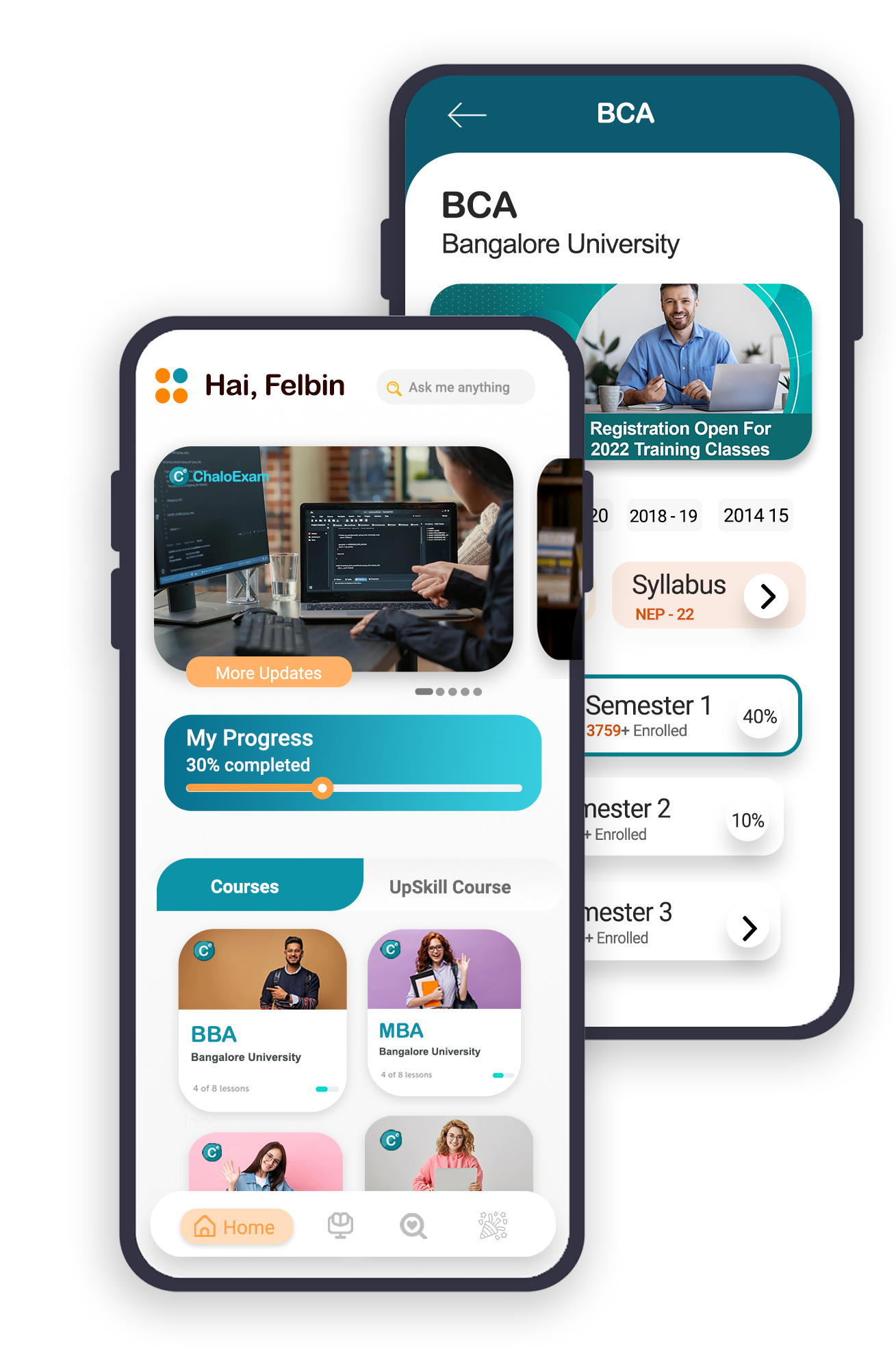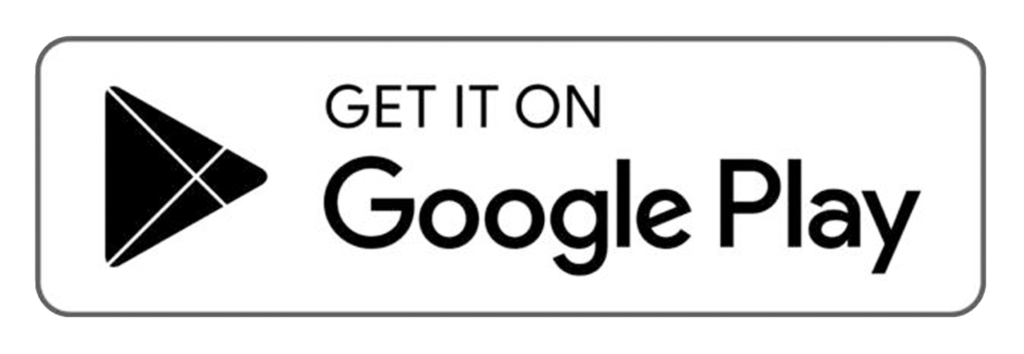Bangalore North University 4th Sem BCOM Study Materials
Download free BCOM 4th sem module wise notes, latest solved question papers, previous 5 years question paper till 2021, model question papers, easy notes, exam-oriented notes are available on this website chaloexam.com of Bangalore North University
Syllabus
4.3 ADVANCED CORPORATE ACCOUNTING
OBJECTIVE
The objective is to enable the students to develop awareness about Corporate Accounting in conformity with the Provision of Companies’ Act and latest amendments thereto with adoption of Accounting Standards.
Unit 1: REDEMPTION OF PREFERENCE SHARES 10 Hrs Meaning – legal provisions – treatment regarding premium on redemption – creation of Capital Redemption Reserve Account– Fresh issue of shares – Arranging for cash balance for the purpose of redemption – minimum number of shares to be issued for redemption – issue of bonus shares – preparation of Balance sheet (vertical forms) after redemption.
Unit 2: MERGERS AND ACQUISITION OF COMPANIES 16 Hrs
Meaning of Amalgamation and Acquisition – Types of Amalgamation – Amalgamation in the nature of Merger – Amalgamation in the nature of Purchase - Methods of Purchase Consideration – Calculation of Purchase Consideration (Ind AS 103) (Old AS14), Net asset Method - Net Payment Method, Accounting for Amalgamation (Problems on both the methods) - Entries and Ledger Accounts in the Books of Transferor Company and Transferee Company – Preparation of new Balance sheet. (Vertical Format) (Excluding External Reconstruction).
Unit 3: INTERNAL RECONSTRUCTION 10 Hrs Meaning – Objective – Procedure – Form of Reduction –Passing of Journal Entries – Preparation of Reconstruction accounts – Preparation of Balance Sheet after Reconstruction. (Vertical Format) Problems.
Unit 4: LIQUIDATION OF COMPANIES 10Hrs Meaning–Types of Liquidation – Order of Payment - Calculation of Liquidator’s Remuneration – Preparation of Liquidators Final Statement of Account.
Unit 5: RECENT DEVELOPMENTS IN ACCOUNTING & ACCOUNTING STANDARDS (Theory Only) 10Hrs Human Resource Accounting – Environmental Accounting – Social Responsibility Accounting – Valuation of Brand.
Indian Accounting Standards- Meaning- Need for accounting standards in India- Accounting standards Board (ASB) process of setting accounting standards in India- A brief theoretical study of Indian accounting standards.
SKILL DEVELOPMENT
∙ List out legal provisions in respect of Redemption of Preference shares.
∙ Calculation of Purchase consideration with imaginary figures.
∙ List any 5 cases of amalgamation in the nature of merger or acquisition of Joint Stock Companies. ∙ List out legal provisions in respect of internal reconstruction.
∙ List out any five Indian Accounting Standards disclosures.
BOOKS FOR REFERENCE
Arulanandam & Raman ; Corporate Accounting-II, HPH
Anil Kumar – Advanced Corporate Accounting, HPH
Roadmap to IFRS and Indian Accounting Standards by CA Shibarama Tripathy
Dr. Venkataraman. R – Advanced Corporate Accounting
S.N. Maheswari , Financial Accounting, Vikas
Soundarajan A & K. Venkataramana, Advanced Corporate Accounting, SHBP.
RL Gupta, Advanced Accountancy, Sultan Chand
K.K Verma – Corporate Accounting.
Jain and Narang, Corporate Accounting.
Tulsian, Advanced Accounting,
Shukla and Grewal – Advanced Accountancy , Sultan Chand
Srinivas Putty, Advanced Corporate Accounting, HPH.
Sreeram & Sreeram, Advanced Corporate Accounting, Adhrash Publishing House.
28
4.4 COST ACCOUNTING
OBJECTIVE
The objective of this subject is to familiarize students with the various concepts and elements of cost.
Unit 1: INTRODUCTION TO COST ACCOUNTING 10 Hrs Introduction – Meaning& Definition of Cost, Costing and Cost Accounting – Objectives of Costing - Comparison between Financial Accounting and Cost Accounting –Designing and Installing a Cost Accounting System – Cost Concepts - Classification of Costs – Cost Unit – Cost Center – Elements of Cost – Preparation of Cost Sheet – Tenders and Quotations.
Unit 2: MATERIAL COST CONTROL 14 Hrs Meaning – Types: Direct Material, Indirect Material. Material Control – Purchasing Procedure – Store Keeping – Techniques of Inventory Control –Levels settings– EOQ – ABC Analysis – VED Analysis – Just In-Time – Perpetual Inventory System – Documents used in Material Accounting - Methods of Pricing Material Issues: FIFO, LIFO, Weighted Average Price Method and Simple Average Price Method - Problems.
Unit 3: LABOUR COST CONTROL 10 Hrs Meaning – Types: Direct Labour, Indirect Labour - Timekeeping – Time booking – Idle Time – Overtime – Labour Turn Over. Methods of Labour Remuneration: Time Rate System, Piece Rate System, Incentive Systems (Halsey plan, Rowan Plan & Taylor’s differential Piece Rate System) – Problems
Unit 4: OVERHEAD COST CONTROL 14 Hrs Meaning and Definition – Classification of Overheads – Procedure for Accounting and Control of Overheads – Allocation of Overheads – Apportionment of Overheads – Primary Overhead Distribution Summary – Secondary Overhead Distribution Summary – Repeated Distribution Method and Simultaneous Equations Method – Absorption of Factory Overheads – Methods of Absorption (Theory Only) – Machine Hour Rate – Problems on Machine Hour Rate.
Unit 5: RECONCILIATION OF COST AND FINANCIAL ACCOUNTS 08 Hrs Need for Reconciliation – Reasons for differences in Profit or Loss shown by Cost Accounts and Profit or Loss shown by Financial Accounts – Preparation of Reconciliation Statement and Memorandum Reconciliation Account.
SKILL DEVELOPMENT
∙ Identification of elements of cost in services sector by Visiting any service sector. ∙ Cost estimation for the making of a proposed product.
∙ Draft the specimen of any two documents used in material account.
∙ Collection and Classification of overheads in an organization on the basis of functions. ∙ Prepare a reconciliation statement with imaginary figures
BOOKS FOR REFERENCE
J. Made Gowda – Cost and Management Accounting , HPH
M.V. Skukla – Cost and Management Accounting
N.K. Prasad: Cost Accounting, Books Syndicate Pvt. Ltd.
Nigam & Sharma: Cost Accounting , HPH
Khanna Pandey & Ahuja – Practical Costing, S Chand
Soundarajan A & K. Venkataramana, Cost Accounting, SHBP.
29
P. K Sinha – Accounting & Costing for Managers.
M.L. Agarwal: Cost Accounting
Dr. Alice Mani: Cost Accounting, SBH.
S.P Jain & Narang: Cost Accounting , Kalyani
Palaniappan and Hariharan : Cost Accounting I.K. International Publishers 12. S.P. Iyengar: Cost Accounting, Sultan Chand ans Sons
S.N. Maheshwari: Cost Accounting, Vikas
M. N. Arora: Cost Accounting, HPH
Dutta: Cost Accounting
V. Rajesh Kumar & R.K. Sreekantha, Cost Accounting – I, Vittam Publications.
30
4.5 E-BUSINESS AND ACCOUNTING
OBJECTIVE:
The objective of the subject is to familiarize the students with E- Commerce models and Tally
UNIT 1. E-BUSINESS 10 Hrs Introduction, E-Commerce – Definition, History of E-commerce, Difference between E - Commerce and E - Business. Comparison of traditional commerce and e-commerce Advantages/ Disadvantages of e-commerce,. E-Commerce business models – major B to B, B to C model, Consumer-to Consumer (C2C), Consumer-to-Business (C2B) model, Peer to-Peer (P2P) model – emerging trends. web auctions, virtual communities, portals, e-business revenue models.
UNIT 2. HARDWARE AND SOFTWARE FOR E-BUSINESS 10Hrs Web server – Internet – World Wide Web - hardware and software for web servers, web hosting choices – shopping cart.
Unit 3: GETTING STARTED WITH TALLY 10Hrs Meaning of Tally software – Features – Advantages - Required Hardware, Preparation for installation of tally software - installation. Items on Tally screen: Menu options, creating a New Company, Basic Currency information, Other information, Company features and Inventory features.
Unit 4: CONFIGURING TALLY 16Hrs General Configuration, Numerical symbols, accts/inv info – master configuration -voucher entry configuration. Working in Tally: Groups, Ledgers, writing voucher, different types of voucher, voucher entry Problem on Voucher entry -Trail Balance, Accounts books, Cash Book, Bank Books, Ledger Accounts, Group Summary, Sales Register and Purchase Register, Journal Register, Statement of Accounts, & Balance Sheet.
Unit 5: REPORTS IN TALLY: 10Hrs Generating Basic Reports in Tally – Financial Statements – Accounting Books and Registers – Inventory Books and Registers – Exception reports – printing reports – Types of Printing Configuration of Options – Printing Format.
SKILL DEVELOPMENT:
∙ Generating the report of journal
∙ Generating the report on cash book
∙ Generating the report on profit and losing account
∙ Generating the report on balance sheet
BOOKS FOR REFERENCE
Raydu – E Commerce, HPH
Suman. M – E Commerc & Accounting - HPH
Kalakota Ravi and A. B. Whinston : Frontiers of Electronic Commerce, Addison Wesley 4. Watson R T : Electronic Commerce – the strategic perspective. The Dryden press 5. Amrutha Gowry & Soundrajana, E – Business & Accounting, SHBP.
C.S.V Murthy- E Commerce, HPH
Agarwala K.N and Deeksha Ararwala: Business on the Net – Whats and Hows of E-Commerce 8. Agarwala K. N. and Deeksha Ararwala : Business on the Net – Bridge to the online store front, Macmillan, New Delhi.
P. Diwan / S. Sharma – E – Commerce
Srivatsava: E.R.P, I.K. International Publishers
Diwan, Prag and Sunil Sharma, Electronic Commerce – A manager guide to E-business, Vanity Books International, Delhi
Tally for Enterprise Solutions
31
4.6. STOCK AND COMMODITY MARKETS
OBJECTIVE:
The objective is to provide students with a conceptual framework of stock markets and Commodity Markets, functionaries in these markets and their mode of trading.
Unit: 1 AN OVERVIEW OF CAPITAL AND COMMODITIES MARKETS: 10 Hrs Primary Market, Secondary Market (Stock Market), Depositories, Private placements of shares / Buy back of shares, Issue mechanism. Meaning of Commodities and Commodities Market, differences between stock market and commodities market.
Unit: 2 STOCK MARKET: 12Hrs History, Membership, Organization, Governing body, Functions of stock Exchange, on line trading, role of SEBI, Recognized Stock Exchanges in India (brief discussion of NSE and BSE). Derivatives on stocks: Meaning, types (in brief).
Unit:3 TRADING IN STOCK MARKET: 14Hrs Patterns of Trading & Settlement – Speculations – Types of Speculations – Activities of Brokers – Broker Charges – Settlement Procedure, National Securities Depository Ltd.(NSDL), Central Securities Depository Ltd.(CSDL) (in brief).
Unit: 4 COMMODITIES MARKET: 12Hrs History, Membership, Objectives, Functions of commodities exchange, Organization and role of commodity exchange, Governing Body, Types of Transactions to be dealt in Commodity Market – physical market, Futures market - Differences between Physical & Future Market, options on commodities exchanges.
Unit: 5 TRADING IN COMMODITY MARKETS: 08Hrs Patterns of Trading & Settlement, Efficiency of Commodity Markets - Size of volumes of Commodities
SKILL DEVELOPMENT
∙ Prepare the list of recognized stock exchanges in India
∙ Prepare the process chart of online trading of shares and debentures.
∙ Prepare the chart showing Governing Body of the Commodities Market.
∙ Prepare the list of commodities traded on commodity market.
∙ Enlist the role of NSDL and CSDL.
BOOKS FOR REFERENCE:
Gurusamy, Financial Markets and Institutions, 3rd edition, Tata McGraw Hill. 2. Saunders, Financial Markets and Institutions, 3rd edition, Tata McGraw Hill. 3. K. Venkataramana, Stock & Commodity Markets, SHBP.
B. Kulkarni – Commodity Markets & Derivatives.
Khan, Indian Financial Systems, 6th edition, Tata McGraw Hill
Bhole, L.M. (2000), Indian Financial Institutions, Markets and Management, McGraw Hill, New York.
Srivastava R.M ; Management of Indian Financial Institutions
Pallavi Modi : Equity – The Next Investment Destination
Prriswami – Indian Financial System
Ghowria Khatoon – Stock & Commodity Markets, VBH.
32
4.7 PRINCIPLES OF EVENT MANAGEMENT
OBJECTIVE:
The objective is to provide students with a conceptual framework of Event Management, Event Services, Conducting Event and Managing Public Relations.
Unit: 1- INTRODUCTION TO EVENT MANAGEMENT 12 Hrs Event- Meaning- Why Event Management- Analysis of Event, Scope of Event, Decision Makers Event Manager Technical Staff- Establishing of Policies & Procedure- Developing Record Keeping Systems.
Unit: 2-EVENT MANAGEMENT PROCEDURE 12 Hrs Principles for holding an Event, General Details, Permissions- Policies, Government and Local Authorities, - Phonographic Performance License, Utilities- Five Bridge Ambulance Catering, Electricity, Water Taxes Applicable.
Unit: 3-CONDUCT OF AN EVENT. 12 Hrs Preparing a Planning Schedule, Organizing Tables, Assigning Responsibility, Communication and Budget of Event- Checklist, Computer aided Event Management– Roles & Responsibilities of Event Managers for Different Events.
Unit: 4-PUBLIC RELATIONS 10 Hrs Introductions to Public Relations- Concept- Nature- Importance- Limitations- Media- Types of Media- Media Management, Public Relation Strategy & Planning. Brain Storming Sessions- Writings for Public Relations.
Unit: 5 CORPORATE EVENTS 10 Hrs Planning of Corporate Event, Job Responsibility of Corporate Events Organizer, Arrangements, Budgeting, Safety of Guests and Participants, Creating Blue Print, Need for Entertainment in Corporate Events And Reporting.
Skill Development
Preparation of Event Plan for Wedding, Annual general body Meeting of an MNC. 2. Preparing Budget for conduct of National level intercollegiate sports events. 3. Preparation of Event Plan for College day Celebrations
Preparation of Budget for Conducting inter collegiate Commerce Fest.
Book References
Event Entertainment and Production – Author: Mark Sonderm CSEP Publisher: Wiley & Sons, Inc. 2. Ghouse Basha – Advertising & Media Mgt, VBH.
Anne Stephen – Event Management, HPH.
K. Venkataramana, Event Management, SHBP.
Special Event Production – Doug Matthews – ISBN 978-0-7506-8523-8
The Complete Guide to successful Event Planning – Shannon Kilkenny
Human Resource Management for Events – Lynn Van der Wagen (Author)
Successful Team Manageemnt (Paperback) – Nick Hayed (Author)
Event Management & Public Relations by Savita Mohan – Enkay Publishing House 10. Event Management & Public Relations By Swarup K. Goyal – Adhyayan Publisher - 2009
33
5.1 ENTREPRENEURSHIP DEVELOPMENT
OBJECTIVE:
To enable students to understand the basic concepts of entrepreneurship and preparing a business plan to start a small industry.
Unit 1: ENTREPRENEURSHIP 10 Hrs Introduction – Meaning& Definition of Entrepreneurship, Entrepreneur & Enterprise –Functions of Entrepreneur - Factors influencing Entrepreneurship - Pros and Cons of being an Entrepreneur – Qualities of an Entrepreneur – Types of Entrepreneur
Unit 2: SMALL SCALE INDUSTRIES 12 Hrs Meaning &Definition – Product Range - Capital Investment - Ownership Patterns – Meaning and importance of Tiny Industries, Ancillary Industries, Cottage Industries. Role played by SSI in the development of Indian Economy. Problems faced by SSI’s and the steps taken to solve the problems - Policies Governing SSI’s.
Unit 3: FORMATION OF SMALL SCALE INDUSTRY 14 Hrs Business opportunity, scanning the environment for opportunities, evaluation of alternatives and selection based on personal competencies. Steps involved in the formation of a small business venture: location, clearances and permits required, formalities, licensing and registration procedure. Assessment of the market for the proposed project – Financial, Technical, Market and Social feasibility study.
Unit 4: PREPARING THE BUSINESS PLAN (BP) 10 Hrs Meaning – importance – preparation –BP format: Financial aspects of the BP, Marketing aspects of the BP, Human Resource aspects of the BP, Technical aspects of the BP, Social aspects of the BP. Common pitfalls to be avoided in preparation of a BP.
Unit 5: PROJECT ASSISTANCE 10 Hrs Financial assistance through SFC’s, SIDBI, Commercial Banks, IFCI - Non-financial assistance from DIC, SISI, AWAKE, KVIC - Financial incentives for SSI’s and Tax Concessions - Assistance for obtaining Raw Material, Machinery, Land and Building and Technical Assistance - Industrial Estates: Role and Types.
SKILL DEVELOPMENT
∙ Preparation of a Project report to start a SSI Unit.
∙ Preparing a letter to the concerned authority-seeking license for the proposed SS Unit ∙ Format of a business plan.
∙ A Report on the survey of SSI units in the region where college is located. ∙ Chart showing financial assistance available to SSI along with rates of interest. ∙ Chart showing tax concessions to SSI both direct and indirect.
∙ Success stories of Entrepreneurs in the region.
BOOKS FOR REFERENCE
Vasanth Desai, Management of Small Scale Industry, HPH
Mark. J. Dollinger, Entrepreneurship – Strategies and Resources, Pearson Edition. 3. Dr. Venkataramana ; Entrepreneurial Development, SHB Publications
34
Udai Pareek and T.V. Rao, Developing Entrepreneurship
Rekha & Vibha – Entrepreneurship Development, VBH
S.V.S. Sharma, Developing Entrepreneurship, Issues and Problems
B. Janakiraman , Rizwana M: Entrepreneurship Development, Excel Books 8. Srivastava, A Practical Guide to Industrial Entrepreneurs
Anil Kumar: Small Business and Entrepreneurship I.K. International Publishers 10. Government of India, Report of the committee on Development of small and medium entrepreneurs, 1975
Bharusali, Entrepreneur Development
Satish Taneja ; Entrepreneur Development
Vidya Hattangadi ; Entrepreneurship
N.V.R Naidu : Entrepreneurship Development, I.K. International Publishers
Advanced Corporate Accounting
Free Videos
Module 1
REDEMPTION OF PREFERENCE SHARES
1)
2)
3)
4)
5)
More Videos For Prime Students
Module 2
MERGERS AND ACQUISITION OF COMPANIES
1)
2)
3)
More Videos For Prime Students
Module 3
INTERNAL RECONSTRUCTION
1)
2)
3)
More Videos For Prime Students
Module 4
LIQUIDATION OF COMPANIES
1)
2)
3)
More Videos For Prime Students
Module 5
RECENT DEVELOPMENTS IN ACCOUNTING & ACCOUNTING STANDARDS
1)
2)
More Videos For Prime Students

Advanced Corporate Accounting
Free Videos
Module 1
REDEMPTION OF PREFERENCE SHARES
1)
2)
3)
4)
5)
More Videos For Prime Students
Module 2
MERGERS AND ACQUISITION OF COMPANIES
1)
2)
3)
More Videos For Prime Students
Module 3
INTERNAL RECONSTRUCTION
1)
2)
3)
More Videos For Prime Students
Module 4
LIQUIDATION OF COMPANIES
1)
2)
3)
More Videos For Prime Students
Module 5
RECENT DEVELOPMENTS IN ACCOUNTING & ACCOUNTING STANDARDS
1)
2)
More Videos For Prime Students
Cost Accounting
Free Videos
Module 1
- 1st chapter (Introduction to cost accounting)
2)
3)
4)
More Videos For Prime Students
Module 2
Material Cost Control
1)
2)
3)
More Videos For Prime Students
Module 3
LABOUR COST CONTROL
1)
2)
More Videos For Prime Students
Module 4
OVERHEAD COST CONTROL
1)
2)
More Videos For Prime Students
Module 5
RECONCILIATION OF COST AND FINANCIAL ACCOUNTS
1)
2)
More Videos For Prime Students

Cost Accounting
Free Videos
Module 1
- 1st chapter (Introduction to cost accounting)
2)
3)
4)
More Videos For Prime Students
Module 2
Material Cost Control
1)
2)
3)
More Videos For Prime Students
Module 3
LABOUR COST CONTROL
1)
2)
More Videos For Prime Students
Module 4
OVERHEAD COST CONTROL
1)
2)
More Videos For Prime Students
Module 5
RECONCILIATION OF COST AND FINANCIAL ACCOUNTS
1)
2)
More Videos For Prime Students
E-Business and Accounting
Free Videos
Module 1
E-BUSINESS
1)
2)
3)
4)
5)
More Videos For Prime Students
Module 2
HARDWARE AND SOFTWARE FOR E-BUSINESS
1)
2)
More Videos For Prime Students
Module 3
GETTING STARTED WITH TALLY
1)
2)
3)
More Videos For Prime Students
Module 4
CONFIGURING TALLY
1)
2)
More Videos For Prime Students
Module 5
REPORTS IN TALLY
1)
2)
3)
More Videos For Prime Students

E-Business and Accounting
Free Videos
Module 1
E-BUSINESS
1)
2)
3)
4)
5)
More Videos For Prime Students
Module 2
HARDWARE AND SOFTWARE FOR E-BUSINESS
1)
2)
More Videos For Prime Students
Module 3
GETTING STARTED WITH TALLY
1)
2)
3)
More Videos For Prime Students
Module 4
CONFIGURING TALLY
1)
2)
More Videos For Prime Students
Module 5
REPORTS IN TALLY
1)
2)
3)
More Videos For Prime Students
Stock and Commodity Markets
Free Videos
Module 1
STOCK AND COMMODITY MARKETS
1)
2)
3)
4)
5)
More Videos For Prime Students
Module 2
STOCK MARKET
1)
2)
3)
More Videos For Prime Students
Module 3
TRADING IN STOCK MARKET
1)
2)
3)
More Videos For Prime Students
Module 4
COMMODITIES MARKET
1)
2)
3)
More Videos For Prime Students
Module 5
TRADING IN COMMODITY MARKETS
1)
2)
More Videos For Prime Students

Stock and Commodity Markets
Free Videos
Module 1
STOCK AND COMMODITY MARKETS
1)
2)
3)
4)
5)
More Videos For Prime Students
Module 2
STOCK MARKET
1)
2)
3)
More Videos For Prime Students
Module 3
TRADING IN STOCK MARKET
1)
2)
3)
More Videos For Prime Students
Module 4
COMMODITIES MARKET
1)
2)
3)
More Videos For Prime Students
Module 5
TRADING IN COMMODITY MARKETS
1)
2)
More Videos For Prime Students
Principles of Event Management
Free Videos
Module 1
INTRODUCTION TO EVENT MANAGEMENT
1)
2)
More Videos For Prime Students
Module 2
EVENT MANAGEMENT PROCEDURE
1)
More Videos For Prime Students
Module 3
CONDUCT OF AN EVENT
1)
2)
3)
More Videos For Prime Students
Module 4
PUBLIC RELATIONS
1)
2)
More Videos For Prime Students
Module 5
CORPORATE EVENTS
1)
2)
More Videos For Prime Students

Principles of Event Management
Free Videos
Module 1
INTRODUCTION TO EVENT MANAGEMENT
1)
2)
More Videos For Prime Students
Module 2
EVENT MANAGEMENT PROCEDURE
1)
More Videos For Prime Students
Module 3
CONDUCT OF AN EVENT
1)
2)
3)
More Videos For Prime Students
Module 4
PUBLIC RELATIONS
1)
2)
More Videos For Prime Students
Module 5
CORPORATE EVENTS
1)
2)
More Videos For Prime Students


